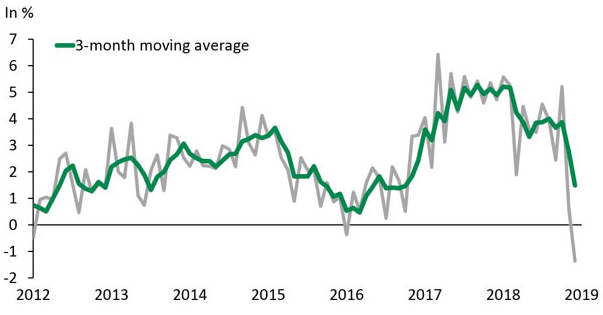Will the Slowdown in the Canadian Economy Be Temporary?
Central banks are less confident
One of the factors that characterized the 2018 economy was slowing global trade. This slowdown intensifies at the end of the year, with the annual change in global trade volume slipping into negative territory. Decreases are fairly rare and reflect weak global economic growth, as in the recent cases of the 2015 plunge in oil prices and the 2012 European debt crisis. Some indicators, such as commodity prices and transport activity, are starting to show small signs of stabilizing, but the trend remains negative. It will no doubt take a resurgence in global economic growth, helped by at least a partial reversal of protectionist measures implemented in 2018, before we can hope for true improvement. At least the ongoing trade negotiations between China and the United States are a step in the right direction.
Graph – Global trade has slowed sharply

Sources: Netherlands Bureau for Economic Policy Analysis and Desjardins Économic Studies
One of the countries hit hardest by the problems in global trade is Germany. Clearly, until Europe’s leading economy strengthens, it will be hard for the Eurozone economy to pick up speed again. A ray of hope may come from the currency’s weakness, which could allow exports to rise again. In short, the growth outlooks for real GDP growth in the Eurozone in 2019 and 2020 have been downgraded again. We now expect it to gain just 1.1% in 2019 and 1.3% in 2020.
China’s economy posted 6.6% annual growth in 2018, its slowest since 1990, and should slow again in 2019. The government has also issued a new target for real GDP growth, moving it from 6.5% to “between 6.0% and 6.5%.” We are expecting the annual change in real GDP to be 6.2% in 2019. Global real GDP growth should be 3.4% in 2019 and in 2020, compared with the 3.6% estimated for 2018.
In the United States, indicators have been fairly volatile since the end of 2018. Added to that was the disruption to the publication schedule caused by the federal government shutdown. It is therefore difficult to get a clear picture of the U.S. economy’s current strength. However, the first quarter of 2019 should reflect the various difficulties the U.S. economy has been subject to since December. For now we are expecting annualized growth of less than 1% this winter. An upswing in confidence and the stabilization of other indicators are nevertheless encouraging, and a rebound is expected this spring. Real GDP growth of 2.5% is expected for 2019 as a whole, with a 2.2% increase expected for 2020.
In Canada, real GDP results for the fourth quarter of 2018 came in below expectations, which were already low. It rose by just 0.4% (annualized quarterly); most significantly, domestic demand fell 1.5%. Clearly, the 0.5% decrease in domestic demand in the third quarter was more than just a fluke, and the situation continued to worsen in late 2018. With the drop in real GDP by industry in November and December, the carryover for the first quarter of 2019 is very small, with temporary problems in the oil industry adding to weak domestic demand. Real GDP could go up by just 0.5% (annualized) in the first quarter. It is expected to rebound this spring, as the oil industry slowly returns to normal. Due to the soft economy at the end of 2018 and in early 2019, we are nevertheless downgrading our forecast for 2019 as a whole. Real GDP growth could be just 1.4% in 2019, followed by a 1.7% gain in 2020.
In Quebec, strong real GDP growth fell to a more moderate pace in 2018. It should continue to flag, as the contribution from households and business will diminish. For one thing, the cumulative interest rate increases ordered since mid-2017 will continue to temper consumer spending. For another, export growth should be slower due to economic difficulties in Europe and an anticipated slowdown to the U.S. economy. Real GDP should grow 1.7% in 2019 and 1.3% in 2020, slower than the estimated 2.3% for 2018.
Regarding financial markets, sentiment has been positive overall in recent weeks. While stock markets continue to do well, bond yields have decreased, as economic numbers remain mixed and central banks are signalling that highly accommodative monetary policy will continue. The Federal Reserve (Fed) is only weakly signalling that further rate hikes could be announced, and it expects to stop reducing its bond holdings next September. The European Central Bank announced a new long-term lending program, in addition to signalling that it would keep its key rates where they are at least until the end of 2019. A less favourable economic situation here forced the Bank of Canada (BoC) to take a much more neutral tone, as well as placing the Canadian dollar at a disadvantage. In its latest statement, the BoC stressed that it will need time to gauge the current situation before contemplating further key rate increases. North American monetary policies should therefore be on hold throughout 2019. A better economic environment should, however, persuade the Fed and the BoC to start raising their key rates again around mid-2020.
